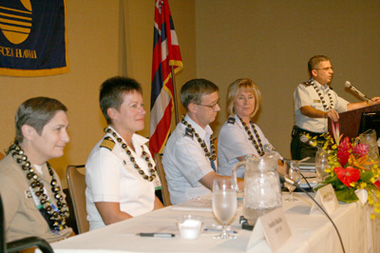 J-6s from across the Pacific include (l-r) Capt. Sandra Buckles, USN, U.S. Forces Japan; Capt. Judie Heineman, USN, Joint Task Force 519; Col. Frederick W. Mooney, USAF, U.S. Forces Korea; Col. Kristine M. Clifton, USAF, U.S. Alaskan Command; and panel moderator Brig. Gen. Ronald Bouchard, USA, U.S. Pacific Command. |
The people responsible for network centricity among their forces have a common item on their wish lists: a new network that addresses current shortcomings and accommodates new capabilities. Little details such as network management, language, security and seams are major impediments to maintaining network centricity, say J-6s from the Asia-Pacific region.
Brig. Gen. Ronald Bouchard, USA, the Pacific Command's J-6, said he needs a scalable network common operational picture with a view from the strategic to the tactical. He wants to leverage technology such as digital sensors and security tools for network management and protection, and he wants better forensics. And, he wants to be able to share information across different platforms and networks.
The problem facing U.S. Forces Korea is the seams between the various networks serving the command's services, said Brig. Gen. Ronald Bouchard, USA, the Pacific Command's J-6. His goal is a consolidated network for SIPRNET, NIPRNET and coalition communications.
Any new network will need detailed and effective bandwidth monitoring and management systems, declared Capt. Judie Heineman, USN, the J-6 for Joint Task Force 519. She wants "a visualization piece that allows us to see what is happening in our networks," she offered.
Capt. Sandra Buckles, USN, the J-6 for U.S. Forces Japan, described many successes in sharing data with Japan. However, a key hindrance is the lack of an automated language translation tool. Saying that it is unfair to expect Japanese forces to have to speak English in their own country, she offered her group to be industry's testbed for an effective language tool.





Comments